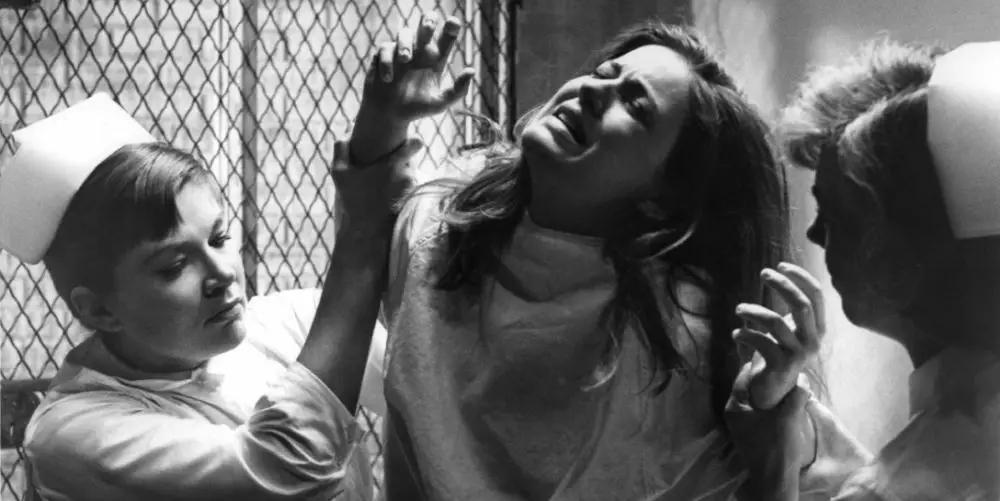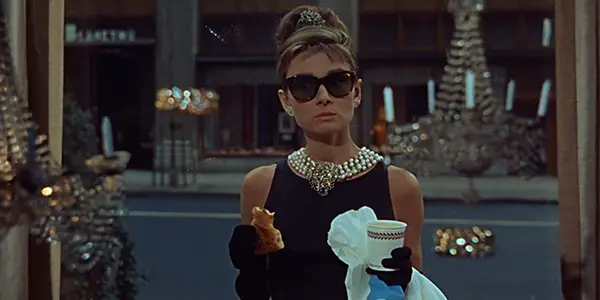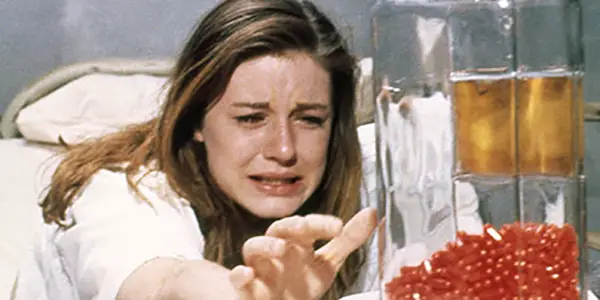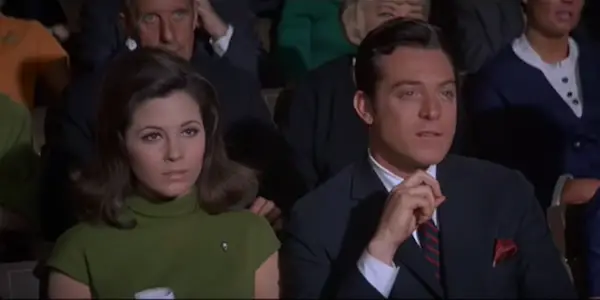VALLEY OF THE DOLLS: Breakfast At Tiffany’s Without Morals Or Class

Sophia Cowley is a young writer, yogi, feminist and film…
The other night, when my friend and I sat down to watch the 1967 cult classic, Valley Of The Dolls, I came across a Netflix member review that claimed: “It’s like Breakfast at Tiffany’s without morals or class.”
“OK, I’m sold,” my friend said.
Valley Of The Dolls tells the classic tale of three women trying to make it in show business, from their rise to fame and fortune to their respective downfalls. But if this film is known for anything – aside from Sharon Tate’s bit role – it’s the movie’s campy, wonderfully bad style. Breakfast At Tiffany’s, on the other hand, has the reputation of a well-crafted, timeless romance.
But this anonymous Netflix reviewer got me thinking: what if Valley Of The Dolls really was Breakfast At Tiffany’s, sans class or morals? I decided to re-watch Breakfast At Tiffany’s to find out. Immediately, I found myself drawing comparisons between the subtexts of the films, while acknowledging their starkly different aesthetics.
Female Desire And Lust For Glamour
One obvious tie between main characters Neely O’Hara from Valley Of The Dolls and Holly from Breakfast At Tiffany’s is their deep desire for all that glimmers in this world. They share a sort of rags-to-riches story, leaving the past behind to pursue a life of glamour. But being fabulous comes at a cost.
Holly is unable to save money or handle finances – she says she never seems to have more than $200 in the bank no matter how much she earns from wealthy male acquaintances, who pay for her to go on dates with them. Interestingly, we typically see Holly either just before she leaves for a date or after she returns home, so we hardly focus on her occupation at all. Therefore, she is depicted in a “classier” light, so to speak.

Holly comes across as a woman of high esteem; she (somehow) lives in a plush townhouse in New York, speaks eloquently and dresses gracefully. Of course, under these layers of luxury lies the reality that Holly is another broke girl lost in New York City.
In contrast, Valley Of The Dolls’ Neely O’Hara dreams of being a Hollywood star. She begins her career in New York as a no-name actress living in a studio apartment. But the whole time, she complains to her husband about how she longs for a larger home, a better role, or more recognition. Amazingly, Neely makes it to Hollywood and establishes a name for herself. But despite her movie-star income, she still struggles to make ends meet, as she crumbles under the pressure.
An important detail to note is that Neely’s addictions, vices and reckless behavior are much more transparent than Holly’s. Neely is seen popping pills (“dolls”) and drinking heavily in many scenes. Meanwhile, the iconic Audrey Hepburn sips champagne and smokes cigarettes, which classifies her as “sophisticated.”
Woman As Consumer And The Fallacy Of Fame
Both Holly and Neely search the shallow sea for material possessions, substances and cheap thrills to fill the void within themselves. Holly indulges in lavish dinners and cigarettes; Neely drinks and does drugs. But these initially innocuous vices eventually reveal themselves as the product of deeply rooted psychosocial crises in the lives of both Holly and Neely.

In Breakfast At Tiffany’s, existentialism and the belief that we are alone in the world are evident themes: Holly refuses to name her cat and says she doesn’t love Paul, her neighbor and good friend, even though she is desperately lonesome and clearly mad for him.
In Valley Of The Dolls, fame and fortune lead to Neely’s emotional and psychological turmoil. Her studio quickly defers her to a shrink, who is supposed to “fix” her, while the real problem lies in the hands of fame, a crazy-making monster.
According to feminist film theorist Mary Ann Doane, a woman’s image is a “commodity,” so when she buys material possessions or consumes substances that make her look and/or feel better, she is actually making an object of herself. In short, women – especially actresses on screens – are constantly selling themselves to the public. Herein lies the mechanism that would drive any star totally mad, such as what happened to Neely in Valley Of The Dolls.
Cinematography And The Making Of A Movie Star
“The female star, along with the commodities (fashions, hairstyles) associated with her image, invite the female spectator to consume and be consumed” – Mary Anne Doane
In a classic scene in Valley Of The Dolls, Helen Lawson (played by Susan Hayward) sings “I’ll Plant My Own Tree” on stage, in front of a colorful, rotating mobile installment. The stage is decked out in modern art, a hallmark of ’60s pop culture. Even more intriguing is the cinematography of this scene, which very purposefully makes a spectacle of Helen.
We see Helen from all angles: first from the audience’s perspective, in wide shot and then in close-up; then the shot totally reverses and we see the back of Helen, facing the audience. The camera dances between the back of her and the front, her figure glimmering in a sequin dress.
This reversal is interrupted by an exchange between Lyon Burke (played by Paul Burke) and Anne (another main character, played by Barbara Parkins). Lyon turns to Anne and says, “Off stage I hate her, but on-stage I’m madly in love with her.” This interjection by Lyon highlights a major conflict in the creation of any female star: that she is, in most cases, designed by and for the eyes of a man.

Anne as a Spectacle (a.k.a. performing on-stage) is adored by men and envied by women, while Anne off-stage is feared and detested by people of all genders. Lyon’s watching Anne and identifying her as a performer is a way of soothing the male ego, because it once again puts her in the familiar context of objectification and makes her a non-threatening thing of beauty. Even Tony Polar, a supporting character, gazes adoringly at Anne from the sidelines.
Feminism In The ’60s
The characters of Valley Of The Dolls and Breakfast At Tiffany’s have something else in common: they are reflective of the second wave feminist movement, which spanned the ‘60s and ‘70s in America. They are rebellious, motivated individuals who rejected the monotony of domestic life and followed career paths that are unconventional.
In 1961, when Breakfast At Tiffany’s was first released, marriage was considered the height of a woman’s life. Those women who found work earned little over 50 cents to every dollar that their male coworkers made. And until 1979, American women were denied access to their husbands’ property or earnings under the Head-and-Master Laws.
The ’60s and ’70s were an exciting – albeit problematic – time for feminists, with the expansion of radical feminism into mainstream consciousness by authors and activists like Kate Millett (who wrote “Sexual Politics”) and Shulamith Firestone (author of “The Dialect of Sex”). I find it interesting how characters such as Holly and Neely arose in Hollywood at this pivotal moment in feminist history.
Conclusion
Valley Of The Dolls may be a less “classy” version of Breakfast At Tiffany’s, but the cult film’s main characters, along with their so-called unlawful dispositions, challenged female narratives in American cinema.
During a time when women were treated like household accessories, films like Valley Of The Dolls and Breakfast At Tiffany’s were important in opening up the minds of movie-goers. If nothing else, these films brought a higher awareness to issues facing feminists and the film industry at large.
Do you think it’s fair to compare Valley Of The Dolls to Breakfast At Tiffany’s? Let us know in the comments!
Does content like this matter to you?
Become a Member and support film journalism. Unlock access to all of Film Inquiry`s great articles. Join a community of like-minded readers who are passionate about cinema - get access to our private members Network, give back to independent filmmakers, and more.
Sophia Cowley is a young writer, yogi, feminist and film enthusiast from NY. Her idols include Miranda July, David Lynch and Abraham Lincoln. She runs the blog www. isthisthereellife.wordpress.com.













